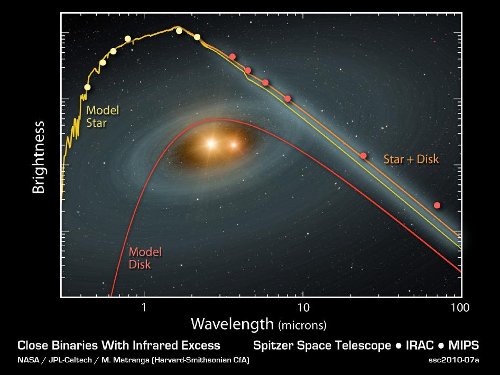Centauri Dreams
Imagining and Planning Interstellar Exploration
Poul Anderson’s Answer to Fermi
Enrico Fermi’s paradox has occupied us more than occasionally in these pages, and for good reason. ‘Where are they,’ asked Fermi, acknowledging an obvious fact: Even if it takes one or two million years for a civilization to develop and use interstellar travel, that is but a blip in terms of the 13.7 billion year age of the universe. Von Neumann probes designed to study other stellar systems and reproduce, moving outward in an ever expanding wave of exploration, could easily have spread across the galaxy long before our ancestors thought of building the pyramids.

Where are they indeed. Kelvin Long, one of Project Icarus’ most energetic proponents, recently sent me Poul Anderson’s thoughts on the subject. I probably don’t need to tell this audience that Anderson was a science fiction author extraordinaire. His books and short stories occupied vast stretches of my youth, and I still maintain that if you want to get not so much the tech and science but the sheer wonder of the interstellar idea, you can tap it in its pure form in his writing. Poul was also the author of Tau Zero, the novel which gave our Tau Zero Foundation its name, and we’re delighted to have Karen Anderson, Poul’s wife, as a valuable part of the organization.
In a letter to the Journal of the British Interplanetary Society in 1986, Anderson sketched the reasons why Fermi was asking his question, citing the von Neumann probes mentioned above, and noting that while interstellar travel was likely hard enough that civilizations practicing it might be rare, all it takes is one to eventually fill the galaxy with its artifacts. He found the notion that Fermi could be answered by saying we are the only high-technology civilization unlikely, but his reason for writing was to offer an entirely different suggestion based on practicality.
Let’s assume a stable civilization arises that achieves extremely long lifespans, if not physical immortality — this may be too big an assumption, but there are those arguing that our successors may be a form of artificial intelligence for whom this could apply. Such a civilization naturally would explore its neighborhood, moving out to local star systems and gradually spreading beyond. Anderson saw this as a problem: The farther from home you go, the longer it takes you to return information. The galaxy itself is 100,000 light years wide, he noted, and that means most information would be utterly outdated by the time it spread throughout the disk.
And what of this self-replication idea? Anderson saw problems there too:
…self-replication would probably already have broken down. Quantum mechanics alone guarantees gradual degradation of the programmes, an accumulation of ‘mutations’ generation by generation — without any natural selections to winnow out the unfavourable majority — until ultimately every machine is useless and every line of its descent extinct.
Can we conjecture a kind of self-healing technology that extends to fixing these errors to maintain the integrity of the expansion? Perhaps, but the data flaw remains paramount:
…long before this has happened, the sphere of exploration will include so many stars that the data flow from them saturates the processing capacity of the present civilisation. After all, with some 1012 stars in the Galaxy, a small fraction amounts to a huge number. Moreover, while they may fall into categories with predictable properties, we are learning in our own back yard that every planet any of them may have is a world, replete with mysteries and surprises. Every life-bearing planet offers endless matter for research, especially since the life will always be changing, evolving.
In short, Fermi’s ‘they’ are not here because they are kept too busy within a few score light-years of their various homes.
If Anderson is right, then we can imagine a galaxy in which technological civilizations arise here and there, each of them gradually filling a sphere of exploration and colonization until a kind of equilibrium is reached and there is no practical advantage to pushing further. Earth, then, could be seen as being in the spaces between such civilizations, not yet aware of their existence, preparing over the next few centuries to begin its own expansion to nearby stars.
Is the galactic population sufficiently dense that such ‘bubbles’ of expansion ever meet? Or is SETI our only chance to confirm the idea that the galaxy has brought forth other technological civilizations? If the latter, we may know them only by the whisperings of their local traffic, exchanging information and perhaps speculating as we do about still more distant suns.
Anderson’s letter appeared in JBIS Vol 39 No (7 July 1986), p. 327.

SETI and the ‘Long Stare’
It’s been a week with an exoplanet focus, what with the interesting Kepler results yesterday and the five, or perhaps seven, planets found around the same star by the HARPS instrument. But I can’t close the week without recourse to Seth Shostak’s recent comments on biological versus machine intelligence. Paul Davies took much the same tack in his recent book The Eerie Silence (Houghton Mifflin Harcourt, 2010), arguing that any civilization we encounter will likely be composed of intelligent machines. Shostak thinks SETI should take that seriously.
Searching for Doppelgängers
Right now we’re searching for what Shostak calls ‘doppelgängers of humans’ — i.e., SETI has focused on places that could support life forms that do more or less what we do, which includes not only using radio to communicate, but much broader traits like living for finite lifetimes, following basic biochemical dictates and being subject to evolution. That biases the search toward places that could sustain life as we know it, a reasonable bias in my opinion, but one that may not take our own development into consideration. After all, we may be living in the short window between developing radio and building true artificial intelligence.
Suppose, Shostak asks in this BBC story (with accompanying audio interview), we develop true AI by the end of this century. What would happen next? This is where things get interesting. Shostak:
At some point they may just pick up and leave, at least some of them, maybe most of them… If you’re a machine, you’re interested in only two things I can think of. And that is matter and energy, because those facilitate whatever it is you’re doing. And matter and energy are not in particularly great supply here.
The result: AI lifeforms go to places more suited for their kind of existence, which could include the galactic core or, perhaps, the neighborhood of a hot, young star. Shostak is arguing that we should allocate a small percentage of our observing time — perhaps up to ten percent — for searching in places AI is more likely to call home. Thus far we’ve searched fewer than a thousand star systems intensively, and our all-sky search is of necessity unable to linger on a target. We’re new at the game, in other words, but let’s tune up our target list.
Is Biology the Issue?
The problem with SETI is that we’re forced to make assumptions about how aliens would operate, an issue that continues to bedevil the field today. Recently we’ve looked at the Benford brothers’ call for a different kind of search, one homing in on the kind of interstellar beacons an alien culture would be likely to create. The discipline is rife with new ideas as we try to figure out the basic parameters that any intelligent species would have to possess in our galaxy. But getting into an alien mind, much less an artificial one, is tricky business. The best we can do is build on our knowledge of physics and extrapolate a line of rational behavior.
The Benfords extrapolate from both physics and economics to argue that an interstellar beacon will likely use short, powerful bursts rather than continuous broadcasts. But SETI has lacked the ‘long stare’ needed to find such a signal. To me, the issue is less AI vs. biology than it is continuous survey vs. pinpoint search. The SETI League’s Project Argus, discussed in these pages recently, is an attempt to set up 5000 amateur receiving stations to implement the ‘long stare.’ It would be a low sensitivity survey, but as the cost of equipment drops and its power increases, it should become possible to implement at the amateur level, and it could be a powerful adjunct to more sophisticated (and focused) searches.
Methods like these could detect an alien beacon, whether built by machine or biological beings, out to several hundred light years, with the sphere of detection growing as we replace older stations with newer technology. They’re a great complement to higher-powered instruments. If we’re looking for beacons, a continuous, high-sensitivity stare along the galactic plane is a sensible way to proceed. But there’s a place for minimal assumptions and broad coverage too, and the advantage of an all-sky survey is that it takes what it finds, which might involve the kind of surprises SETI is made for.

New Kepler Planets in Resonance
Somewhere around 2000 light years away in the direction of the constellation Lyra is a Sun-like star orbited by at least two Saturn-class planets. What’s interesting about this news, as just discussed in the Kepler press conference I’ve been listening to this afternoon, is that for the first time we’ve detected and confirmed more than one planet around a single star using the transit method. But much more important, transit timing variations — the leads and lags of the two planets as they transit the star as seen from Kepler — can be used to tease out new and significant information.
Kepler-9b and 9c mark the first clear detection of transit timing variations by Kepler, allowing us to study the gravitational interactions between the planets involved. And that’s useful stuff: We see two planets in a 2:1 orbital resonance, one with a 19.2-day orbit, the other with a 38.9-day orbit. As the inner planet completes two orbits, the outer planet completes one. The variations in transit time (TTV) help us establish the mass of the two planets, showing that both have a mass and radius slightly smaller than Saturn. Peg size and mass and you can derive planetary density.
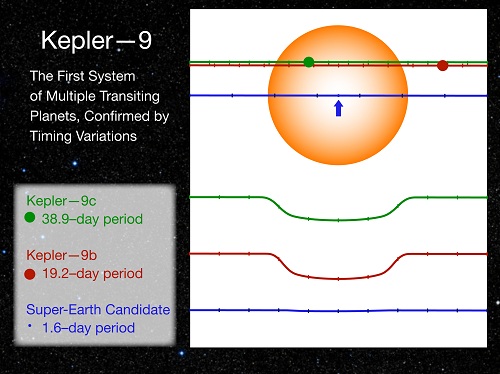
Image: Lightcurves of the Kepler 9 system. Credit: Matthew Holman (Harvard-Smithsonian Center for Astrophysics).
We’ve known for some time that transit timing variations should be a useful part of the exoplanet toolbox, but seeing them working in practice is a powerful proof of concept. The hope, of course, is that similar TTV methods can be put to work on smaller worlds down to terrestrial mass planets in the habitable zones of their stars. In fact, in this case, the Kepler 9 system sports a candidate that is 1.5 times the radius of Earth, a possible super-Earth whose barely detectable signature is not yet sufficient for us to declare the planet confirmed.
The other aspect of the Kepler 9 system that received discussion at the news conference was what it can tell us about planetary formation theories. These planets orbit well within the orbit of Mercury in our own system, and the assumption is that they could not have formed there. Planetary migration resulting in a 2:1 orbital resonance is something that points back to an earlier set of conditions whose nature will take many more precision measurements — in this and many other systems — to understand. But ultimately, the way a planetary system looks today can reveal much about its history.
Is there good news in this for terrestrial worlds? Not yet, but there is at least a hint. Alycia Weinberger (Carnegie Institution of Washington) made this case at the conference:
Ultimately Kepler will find many multiple planet systems. We will know how many systems show these resonances, how often and when different kinds of migration occurred while planets were forming. Our 1.5-Earth radius candidate, if real, survived whatever migration it and the other planets went through, a fact that bodes well for systems with substantial migration.
In other words, the Kepler 9 system may eventually tell us that the movement of gas giants into the inner system does not necessarily spell the doom of smaller worlds there, if and when we confirm the existence of the super-Earth. Weinberger goes on:
It would be interesting to know that planetary systems with different histories can produce low mass planets or planets more Earth-like in size. Resonances like those Kepler-9b and 9c demonstrate can ensure stability and produce planetary systems that last billions of years. Frequent resonances, in other words, are good news for low mass planets, giving them stable orbits. And transit timing variations can help us deduce the masses of the planets involved.
Not a bad haul for this interesting system, about which we’ll learn more as the Kepler mission progresses. As I said above, produce figures on the size and mass of a planet and you can derive its density, helping astronomers understand its composition, from gaseous to rocky or water planets. We’ll see what transpires with that candidate super-Earth — if it’s there, it’s in a scorching 1.6-day orbit, another hellish world singed by its star. But perhaps Kepler 9 helps point the way to a future news conference when an Earth-like planet in the habitable zone will be announced.

HD 10180: A Planetary Harvest
In a sense the planets discovered around the Sun-like star HD 10180 are no surprise. We’ve long assumed that planetary systems with numerous planets were common. We lacked the evidence, it’s true, but that could be put down to the limitations of the commonly used radial velocity method, which favors massive worlds close to their stars. But we’re getting much better at radial velocity work and, using instruments like the HARPS spectrograph at the European Southern Observatory’s La Silla (Chile) telescope, we’re teasing out ever more exquisite signals from distant systems. More and more multiple-planet scenarios are in our future.
Noting that high-precision radial velocity surveys are now able to detect planets down to roughly 1.9 Earth masses, the paper on the HD 10180 work frames the situation this way:
Preliminary results from the HARPS survey are hinting at a large population of Neptune-like objects and super-Earths within ?0.5 AU of solar-type stars (Lovis et al. 2009). Moreover, hundreds of small radius candidate planets have been announced by the Kepler Team (Borucki & the Kepler Team 2010). Clearly, the exploration of the low-mass planet population has now fully started, and will become the main focus of the field in the coming years.
But five planets at one go is still an eye-opener, especially when you consider that two others are also possible here. It took six years of study of this star, some 127 light years away in the constellation Hydrus, to bag the five leading signals, representing planets like Neptune in being between 13 and 25 Earth masses. These worlds circle their star in orbits that range from six to 600 days at distances between 0.06 and 1.4 AU. Some accounts are citing similarities with our Solar System because of the number of worlds, but we might just as well note the differences, including the crowding of the inner system and the presence of massive planets there.
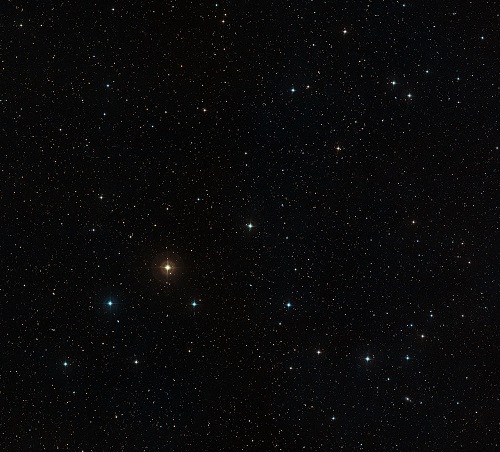
Image: This wide-field image shows the sky around the star HD 10180, which appears as a fairly bright star just below the centre. The picture was created from photographs taken through red and blue filters and forming part of the Digitized Sky Survey 2. The field of view is approximately three degrees across. The coloured halos around the stars are artifacts of the photographic process and are not real. The remarkable planetary system around this star is far too faint and close in to be visible in this image. Credit: ESO, Digitized Sky Survey 2. Acknowledgement: Davide De Martin.
The paper notes that systems like this open up new realms of study:
It is expected that the characterization of planetary system architectures, taking into account all objects from gas giants to Earth-like planets, will greatly improve our understanding of their formation and evolution. It will also allow us to eventually put our Solar System into a broader context and determine how typical it is in the vastly diverse world of planetary systems. The characterization of a significant sample of low-mass objects, through their mean density and some basic atmospheric properties, is also at hand and will bring much desired insights into their composition and the physical processes at play during planet formation.
Those two additional worlds, whose existence Christophe Lovis (Observatoire de Genève), lead author of the cited paper, says is supported by solid evidence, include a 65 Earth-mass gas giant in a 2200-day orbit and a world that, if confirmed, would be the least massive exoplanet yet discovered, with a mass of about 1.4 times that of the Earth. This one is not exactly a candidate for astrobiology, though, orbiting the host star at a distance so close (0.02 AU) that a planetary year lasts a mere 1.18 Earth days. This ESO news release likens the possible world to the rocky inferno CoRoT-7b.
If there were a gas giant like Jupiter in this system, we should have evidence of it. And note that the orbits of all these planets seem to be almost circular. Says Lovis:
“Systems of low-mass planets like the one around HD 10180 appear to be quite common, but their formation history remains a puzzle.”
Although HD 10180 presents us with one of fifteen planetary systems known to have at least three worlds, that number will grow quickly. The new planets were found in a radial velocity survey of about 400 bright FGK stars in the solar neighborhood using HARPS, and the paper notes that ‘many new systems are about to be published.’ We’re homing in on the ability to derive statistical properties of the low-mass planet population, a new phase in the exoplanet hunt, one that focuses on complex planetary systems rather than individual planets.
From the paper:
The HD 10180 system shows the ability of the RV technique to study complex multi-planet systems around nearby solar-type stars, with detection limits reaching rocky/icy objects within habitable zones. Future instruments like VLT-ESPRESSO will build on the successful HARPS experience and carry out a complete census of these low-mass systems in the solar neighborhood, pushing towards planets of a few Earth masses at 1 AU.
The paper, submitted to Astronomy & Astrophysics, is Lovis et al., “The HARPS search for southern extra-solar planets. XXVII. Up to seven planets orbiting HD 10180: probing the architecture of low-mass planetary systems” (full text).

Twin Suns May Spell Disaster
The image of double suns rising over the planet Tatooine from the first Star Wars movie never quite goes away. I remember watching the film in a theater about a week after its release, being dazzled by the visuals but thinking that a planet in an orbit around both stars of a binary would have to be well outside the habitable zone. I didn’t believe in Tatooine, in other words, though now I’m a bit more circumspect. A couple of years ago Cheongho Han (Chungbuk National University, Korea) wrote a paper suggesting that microlensing might be of use in finding a planet fitting this description, if indeed such a planet exists.
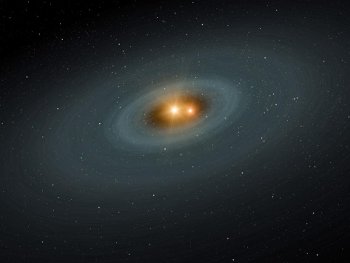
Then yesterday Massimo Marengo dropped me a note about new work he has been involved in that puts a damper on the idea of terrestrial worlds in such settings. Long-time Centauri Dreams readers will remember Marengo, whose fascinating work on Epsilon Eridani we’ve covered in these pages on several previous occasions. Now at Iowa State University, the astrophysicist has been studying tight double-star systems, using data harvested from the Spitzer Space Telescope.
Working with principal investigator Jeremy Drake (Harvard-Smithsonian Center for Astrophysics), Marengo and team are learning that the problem with tight binaries is the chance for planetary collisions. We’re talking about a class of binaries called RS Canum Venaticorums (RS CVns) that are separated by something on the order of 3.2 million kilometers, roughly two percent of the distance between the Earth and the Sun. That produces orbits of just a few days and tidal lock, with each star presenting the same face to the other.
Image: This artist’s concept illustrates a tight pair of stars and a surrounding disk of dust — most likely the shattered remains of planetary smashups. Using NASA’s Spitzer Space Telescope, the scientists found dusty evidence for such collisions around three sets of stellar twins (a class of stars called RS Canum Venaticorum’s or RS CVns for short). Credit: NASA/JPL-Caltech.
Imagine two stars similar to the Sun in size and about as old as the Sun when life first evolved on the Earth. They’re possessed of strong magnetic fields and giant spots, the result of their fast spin, and the magnetic fields, in turn, drive powerful stellar winds that slow the stars and pull them closer together over time. Now things get tricky, for the new work suggests that the gravitational influences of the stellar pair continually change as the stars approach each other, causing planets and other objects circling the stars to experience collisions.
Says Marc Kuchner (NASA GSFC):
“These kinds of systems paint a picture of the late stages in the lives of planetary systems. And it’s a future that’s messy and violent.”
Indeed. And the evidence from Spitzer seems tight. The instrument can see the glow of hot dusky disks around three tight binary systems matching this description. The thinking is that the dust found here would normally have dissipated from stars at this level of maturity. Something, in other words, is causing fresh dust to be created, implying a chaotic process. Planetary collisions are the most likely candidate.
Image: Spitzer’s cameras, which take pictures at different infrared wavelengths, observed the signatures of dust around three close binary systems. Data for one of those systems are shown here in orange. Models for the stars and a surrounding dusty disk are shown in yellow and red, respectively. The disk reveals that some sort of chaotic event — probably a planetary collision — must have generated the dusty disk. Credit: NASA/JPL-Caltech/Harvard-Smithsonian CfA.
We know that planets can exist around closely-spaced binaries — a tight eclipsing binary system called HW Virginis, for example, is known to be orbited by two gas giants. But HW Virginis c has a semi-major axis of 3.6 AU, while HW Vir b is at 5.3 AU. Both are well outside the habitable zone of the stars they orbit. In any case, this binary system involves a B-class and an M-class star, not the kind of system depicted in Tatooine or examined in the current work.
With the stars under study, we have more of a When Worlds Collide scenario than anything from Star Wars. Here’s Jeremy Drake on the matter:
“This is real-life science fiction. Our data tell us that planets in these systems might not be so lucky — collisions could be common. It’s theoretically possible that habitable planets could exist around these types of stars, so if there happened to be any life there, it could be doomed.”
Another exoplanet orbiting twin stars is found around the binary PSR B1620-26, but here again, we’re not exactly dealing with Sun-like stars. The planet involved orbits a pulsar and a white dwarf. And back to Cheongho Han for a moment. The scientist believes that if a terrestrial world did exist in a stable orbit around two stars similar to our Sun, the only way to find it would be through microlensing. Radial velocity studies avoid short-period binaries, but the microlensing signature should be detectible. Marengo and Drake’s work suggests that if such a world is found, it may be a rarity indeed.
The paper is Matranga et al., “Close Binaries with Infrared Excess: Destroyers of Worlds?” Astrophysical Journal Letters 720 (August, 2010), L164 (preprint). Cheongho Han’s paper is “Microlensing Search for Planets with Two Simultaneously Rising Suns,” Astrophysical Journal Letters 676, No. 1 (20 March 2008), L53 (abstract).

Pulsar Timing: An Outer System Tool
The ways astronomers find to wrest new findings from raw data never ceases to amaze me. This news release from the Max-Planck-Institut für Radioastronomie focuses on a new way to weigh the planets in our Solar System by using signals from pulsars. The method flows out of work on pulsar timing that has been used in the hunt for gravitational waves and has implications not just for the known planets but for detecting hitherto unknown objects in our system.
Pulsar timing supplements earlier ways of weighing planets by measuring their effect on spacecraft flown past them, or extrapolating information from the orbits of their moons. And it seems to be hugely sensitive, to just 0.003 percent of the mass of the Earth and one ten-millionth of Jupiter’s mass.
“This is first time anyone has weighed entire planetary systems – planets with their moons and rings,” says team leader Dr. David Champion (MPIfR). “In addition, we can provide an independent check on previous results, which is great for planetary science.”
So how does this work? The reception of pulsar signals is affected by the Earth’s movement around the Sun, an effect that can be removed by calculating when the pulsar signals would have reached the Solar System’s center of mass, or barycenter, which is the rotation center for all the planets. As you would imagine, the barycenter itself moves as the planetary positions change over time. An ephemeris charting the position of the planets can be used to work out the barycenter’s position according to the values for their masses that have been measured.
Any error in the calculation of the barycenter causes repeating timing errors in the pulsar data. Dick Manchester (CSIRO/Australia) says that “…if the mass of Jupiter and its moons is wrong, we see a pattern of timing errors that repeats over 12 years, the time Jupiter takes to orbit the Sun.” Correct the mass of Jupiter and its moons and the timing error disappears.
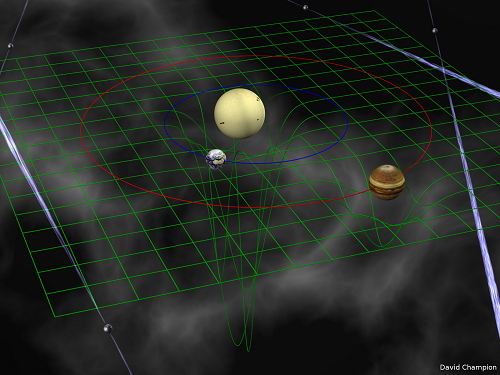
Image: Planets in the solar system with their masses determined by means of pulsar timing observations. Credit: David Champion.
Thus far the method has been used to weigh Mercury, Venus, Mars, Jupiter and Saturn (with moons and rings). The mass of the Jovian system can be calculated to a value far more accurate than the best Pioneer and Voyager spacecraft results, though not quite as accurate as the value measured by the Galileo spacecraft. Spacecraft will continue to be the best source of planetary weight measurements, but for planets not being probed by spacecraft, the pulsar measurement will provide accurate data, becoming more accurate as measurements are repeated over time.
This story takes us deep into the Solar System and involves more than the known planets. The kind of data being used may help us with a variety of unknown bodies. From the paper:
The pulsar timing technique is also sensitive to other solar system objects such as asteroids and currently unknown bodies, e.g., trans-Neptunian objects (TNOs). Measurements of anomalous period derivatives and binary period derivatives for a number of millisecond pulsars have already been used to place limits on the acceleration of the Solar System toward nearby stars or undetected massive planets… Pulsar timing array experiments with a wide distribution of pulsars on the sky will be sensitive to the dipolar spatial dependence resulting from any error in the solar system ephemeris, including currently unknown TNOs.
Thus exquisitely sensitive timing data gathered at Parkes, Arecibo and the German Effelsberg instrument, useful in the search for gravitational waves, opens up a new investigative tool for planetary measurement and the hunt for unknown bodies in our system. It’s easy to see why this emerged: The kind of tiny changes in pulsar timing that could flag gravitational waves has to be distinguished from timing error caused by objects in our Solar System. And this is interesting:
Limits for unknown masses have also been placed by spacecraft using deviations from their predicted trajectories. Doppler tracking data from the two Pioneer spacecraft were searched for accelerations due to an unknown planet. The anomalous acceleration detected in these data… is attributed to non-gravitational sources (Anderson et al. 2002) and is not detected in planetary measurements (Folkner 2010).
The paper is Champion et al., “Measuring the Mass of Solar System Planets Using Pulsar Timing,” to be published in The Astrophysical Journal. Also interesting (in terms of distributed science) is Knispel et al., “Pulsar Discovery by Global Volunteer Computing,” Science Express (12 August 2010). Abstract here.

